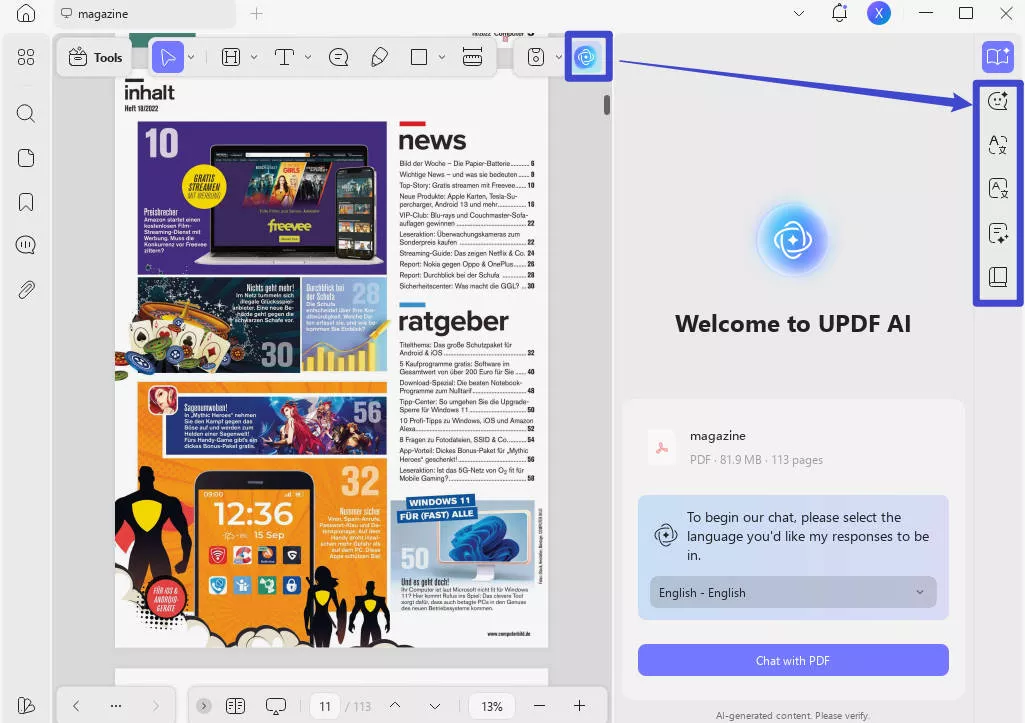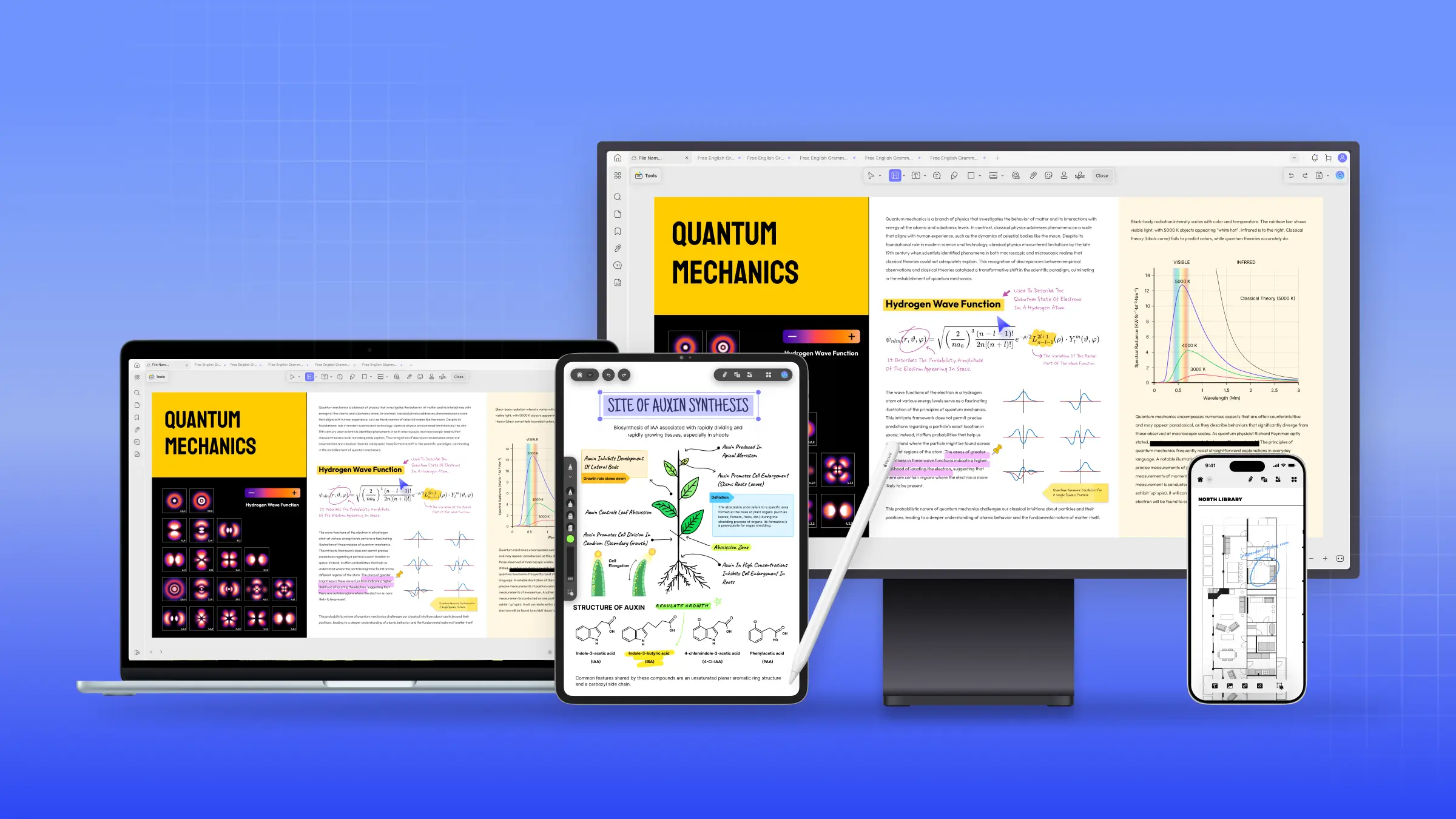Are you a college student wanting to learn how to write an effective and engaging book review? Learning the different elements of writing successful reviews can help you hone your critical analysis and communication skills while also giving your opinions on books that may be interesting to fellow students.
We’ve compiled the best book review examples for college students so that you can get an idea of what makes for compelling, impactful book reviews and how to write a book review as a college student. Also, we will introduce one awesome tool, UPDF, to help you write the book review you need. You can download UPDF by clicking the below button then, check with us about how it can help you write your book review.
Without wasting time, let's go to check.
Windows • macOS • iOS • Android 100% secure
Part 1. What is A Book Review?
A book review is an objective and comprehensive evaluation of a particular book. It assesses the book's content, style, and relevance to the field it covers. Written by scholars, experts, or avid readers, book reviews provide potential readers with an insight into the quality, content, and significance of a given book. They are usually written in newspapers, magazines, online platforms, and academic journals.
Book reviews can be used as a valuable resource for readers who want to make an informed decision when choosing what to read. For college students especially, reading reviews can help them gain insight into books that may be interesting and helpful for their studies.
Part 2. What Should A Book Review Include?
Here's an in-depth overview of the elements of a book review:
1. Basic Information
In a book review, the basic information section provides readers with information on the:
- Author's name
- Date of publication
- Genre
- Page count
- Other relevant details
In today's age where customer ratings and reviews play an important role in helping potential readers decide if a book may be worth their time and money, customer ratings from popular websites such as Amazon or Goodreads are also included in this section.
Providing readers a place to buy the book at the end of the review ensures they can easily locate it and make the purchase if they wish to do so.
As such, this section provides a helpful overview of what the book entails without risking spoilers or giving away plot points that may take away from the reading experience.
2. Plot
A thorough book review should provide an analysis of how a story is developed by the author. It should pay special attention to examining how the plot progresses from beginning to end, what characters are introduced and how they help move the story forward, and any underlying themes or messages that contribute meaningfully to the narrative.
A successful book review will look at each of these elements in depth, explaining the important events, relationships between characters and themes, and why they all matter.
By providing readers with an understanding and appreciation of this complex structure created by the author, a book review can bring added insight into why certain books work so well for certain readers.
3. Quotes
Quotes from the book can be a great way to support your review and provide a vivid illustration of why certain portions of the book are so insightful or humorous. This also helps readers have an understanding of what to expect when reading the book, aiding them in deciding if this is something they would like to spend their time with.
Quotes should be chosen well and given in a way that they maintain the integrity of the book’s content while still providing an accurate representation of what to expect when reading it.
4. Your Thoughts After Reading
This is the most important and personal part of any book review. Here, you will be able to share your own opinion on the book and give it a rating. This section should not just focus on your feelings about the book, but also provide an in-depth analysis of how it made you feel, what stayed with you after reading it, and why. This is your opportunity to explain why you would or wouldn’t recommend this book to others, so use it well.
You may also provide some helpful advice on who would best enjoy this book, such as what age group it's most suitable for or if there are particular topics that it may be helpful to those who are more deeply interested in.
5. Your Rate
At the end of a book review, you should provide your own rating of the book (on a scale from 1 to 5 stars or whatever other rating systems you prefer).
Your rating should reflect your honest opinion and provide readers with an understanding of how much you enjoyed the book. It is also important to remember that ratings are subjective and should be based on your individual experience with the book.
Your rating should reflect your opinion of the quality of the writing, the characters, and the overall story that you experienced while reading. This rating should be your final opinion on the book and will help potential readers in deciding if it is something they would like to commit their time and money to.
6. Conclusion
A great book review should end with a concise summary of the work as a whole. Here you should include your overall opinion on the book and what elements you found most enjoyable. This can help readers gain a better understanding of why the book was so successful, and how it may have impacted your life in some way.
This is also a great place to provide readers with information on where they can find the book so that they can look into it further if they choose to do so.
Part 3. 10 Book Review Examples for Students
Book review examples are a great way for students to get more out of the books they read. Not only do examples of book reviews provide readers with an in-depth evaluation of the book’s content and quality, but they also offer students an opportunity to practice their critical thinking and writing skills.
To help you get started, we have compiled 10 book review examples for students.
1. The List That Changed My Life By Olivia Beirne Book Review Example
This example of a book review offers an honest and detailed analysis of the book. It highlights both the positive aspects, such as the strong relationship between Georgia and her sister, as well as some of the more contrived elements of the plot.
Providing a thorough assessment, it allows readers to make an informed decision before deciding whether or not to pick up the book. Additionally, the review is written in a professional and accessible tone, making it enjoyable to read.
2. The People We Keep By Allison Larkin Book Review Example
This example of a book review does an excellent job of providing a comprehensive look at the novel, covering elements such as the characters, setting, plot, and themes. It provides a well-rounded overview that will give potential readers an accurate idea of what to expect from the book.
Additionally, it includes personal insights from the reviewer which adds a level of depth and enthusiasm that can help pique the interest of potential readers.
3. Brave New World by Aldous Huxley Book Review Example
This example of a book review provides an in-depth look at Brave New World and its themes. It clearly explains the book's content and offers a thoughtful analysis of the ideas presented.
The reviewer also provides some insight into their personal experience with the novel which makes it more relatable to other readers. Additionally, the reviewer offers advice on who they think the book is suitable for, making it easier to decide if the book is right for them.
4. Lord Of The Flies by William Golding Book Review Example
This example of a book review offers an honest and detailed evaluation of the book "Lord of the Flies" which makes it helpful for readers who are considering reading this book.
The review offers a thoughtful perspective on how young adult readers may appreciate the story, as well as provides information about where to buy the book.
Additionally, the review covers key plot points such as the Lord of the Flies and how the events escalated, as well as pointing out potential plot holes. This makes it an excellent resource for readers looking to gain a better understanding of this classic novel.
Finally, this review provides insight into how easily human nature can be manipulated which is an important point that is often overlooked.
All in all, this review is an excellent resource for readers interested in the book "Lord of the Flies" and offers an informed opinion on what to expect.
5. To Kill A Mockingbird by Harper Lee Book Review Example
This example of a book review offers a comprehensive overview of Harper Lee's classic novel, To Kill A Mockingbird. It provides an analysis of the book's characters and themes, giving readers a clear understanding of why it is considered one of the greatest novels ever written.
Additionally, it touches on various topics such as racism and sexism that are still relevant today.
This review is a great resource for readers who are looking to gain a deeper understanding of the novel and its themes. It is also useful for readers who want to get a better idea of how Lee's writing style has stood the test of time.
Finally, it provides an insightful look into why To Kill A Mockingbird continues to be read and enjoyed worldwide. Therefore, it is a great review to check if you are considering picking up this classic book.
6. This Side of Paradise by F. Scott Fitzgerald Book Review Example
This review example is a great resource for students to use as an introduction to book reviews. It provides them with a comprehensive overview of the content and structure of a typical book review, while also highlighting some of the unique features that make This Side of Paradise so special.
In addition, reading it gives readers an insight into the historical context in which Fitzgerald wrote, making it an invaluable tool for literary analysis and appreciation.
Finally, the review also contains insightful comments about Fitzgerald's writing style, which may provide valuable tips for aspiring authors.
7. Crime and Punishment by Fyodor Dostoyevsky Book Review Example
This example of a book review provides a comprehensive overview of Dostoevsky's 'Crime and Punishment', highlighting the pros and cons of the work. It also offers insight into the characters and their relationships, as well as an in-depth look at Dostoevsky's purpose for writing the novel - to defeat nihilism.
Students should read this review example to gain a better understanding of Dostoevsky's masterpiece and the impact it had on 19th-century literature.
Students can also learn valuable lessons from the novel, such as how to think critically about radical ideas and how not to fall into nihilism. Additionally, by studying this review example students can develop their own critical analysis skills. They can learn how to identify a work's strengths and weaknesses, as well as its overarching themes and purpose. This review example provides students with the perfect starting point for further research into 'Crime and Punishment' and Dostoevsky's other works.
8. The Great Gatsby by F. Scott Fitzgerald Book Review Example
This example of a book review shows how to analyze a text analytically and draw conclusions about the book's themes, characters, and motifs. It provides an in-depth look at how different elements of the book combine together to create a powerful story.
Additionally, this review provides insight into why certain aspects of the novel might be interpreted differently by different readers. By reading this review, students can gain a better understanding of the novel, its themes, and how they may relate to their own lives. This will help them form their own opinions on the book and connect with it more deeply.
9. Animal Farm by George Orwell Book Review Example
This review example of Animal Farm by George Orwell provides an in-depth analysis of the book that goes beyond a basic plot summary. It uses historical events to illustrate many of the themes present in the novel, and it also explores how religion can be used to control people's thoughts and actions.
By reading this example of a book review, students can get a better understanding of the book, its characters, and its broader messages. Furthermore, it provides a useful template for writing their own reviews of the book in preparation for exams or other assignments.
Overall, this review serves as an informative introduction to Animal Farm and is sure to help students better understand the themes present in the novel.
10. The Power of Habit by Charles Duhigg Book Review Example
This example of a book review offers a great insight into the power of habits and how they can be changed. It includes an explanation of the principles behind habit formation and highlights some tips for creating new habits to replace old ones. The review also provides an engaging story that showcases how these principles worked in one person's life, which is helpful for readers who are looking for personal insight and motivation.
Additionally, this review includes an infographic that summarizes the key points from the book, making it easy for students to understand and remember the material. This example is a great reference point for anyone looking to apply the principles of habit formation in their own lives.
Part 4. How to Write a Perfect Book Review As a College Student?
Writing an effective and meaningful book review can be tough, but it doesn’t have to be. With the right approach and some helpful tips, anyone can craft a great book review.
We will walk you through how to write a book review example, from taking notes while reading to writing your first draft and beyond.
So if you want to know what it takes for success in this endeavor, read on!
Step 1. Taking Notes When Reading
The first step in writing a book review is to take notes while you read the book. This will help you remember key points and details that you can reference when writing your review.
If you are reading a PDF format book, we recommend using the UPDF app to take notes. If you do not know which sites can download e-books in PDF formats, you can check these 10 e-book download websites.
UPDF gives users the ability to highlight text, add comments and annotations, and stickers to their PDF book – all within a single interface. You can download UPDF here and follow the below guide to take notes.
Windows • macOS • iOS • Android 100% secure

Here's how to use UPDF for note-taking:
1. Select the book you want to read and select "Open File" to open it in the UPDF .

2. Head to the left toolbar and click on the "Comment" in "Tools".

3. Now you can add comments in four ways:
- Text Comment (Typewriter) – add comments in the form of text.
- Text Box – insert a box to write down your thoughts.
- Text Callout – add the text callout feature.
- Sticky Note – add a sticky note to mark important points.

4. Once you have added your comments, click save and you’re done!
By taking notes with UPDF, you can easily refer back to your notes when it's time to write your review. Moreover, you can explore the comments directly.
What I like most about UPDF is that it has AI features that can help me summarize the whole book in seconds, explain the difficult terms for me, and translate the language into the one you can understand.

Why not download UPDF via the below button to make your book review writing much easier?
Windows • macOS • iOS • Android 100% secure
And UPDF does not only have the features mentioned above. You can know all its features by reading this UPDF review article from Laptopmedia or watching the below video tutorial.
Also Read: 5 Best Note-taking Apps for Students
Step 2. Outline the Book Review
Before you start writing your review, it is important to create an outline. This will help you organize your thoughts and identify the main points of your review.
A general outline for a book review should include:
Introduction: Provide an overview of the book and explain its main takeaways.
Summary: Summarize the plot, characters, and themes of the book.
Analysis: Analyze the author's writing style and technique, as well as the book's overall message.
Opinion: Share your personal opinion on the book and any ideas or insights you've gained by reading it.
Final Thoughts: Wrap up your review with a conclusion.
Step 3. Checking Book Reviews Examples
Before writing your own review, it can be helpful to check examples of book reviews. A good example of a book review provides an insightful analysis of what makes the book worth reading, highlighting both its strengths and weaknesses.
As you go through examples, take note of the structure and tone used in each review. You can also take note of any key points in the book that may have been overlooked or not covered.
Reading reviews can help you get a better understanding of the book and gain valuable insights into its content, in preparation for exams or other assignments.
Step 4. Writing the First Draft
Now that you have taken notes and created an outline, it is time to start writing your first draft. As you write, remember to keep the tone of your review professional and unbiased.
Make sure to include in-text citations and a list of any sources you use when relevant, as this will add credibility to your review. Additionally, use language that is easy to understand, and don’t be afraid to inject some of your own thoughts and opinions.
Once you have written the first draft, take a break and come back to it with fresh eyes before revising and editing.
Step 5. Reread The Book Review and Update
Once you have written the first draft of your book review, it is important to reread it and make any necessary updates. Pay close attention to any grammar, spelling, and punctuation mistakes. Additionally, ensure that all the points you mentioned in your review are accurate and true to the book's content.
Finally, make sure you have written in an organized and coherent manner that is easy for the reader to follow.
Conclusion
Writing a book review for college students can seem challenging but with the right preparation and some helpful tips, anyone can craft a great book review. By taking notes when reading, creating an outline before you start writing, checking book review examples, and revising your work after writing the first draft - you can create a thoughtful and insightful review. And we are sure these 10 book review examples for college students will be very helpful to you.
So, the next time you are assigned to write a book review, keep these tips in mind and you will be sure to impress your teacher or professor.
If you're up for a challenge, try using UPDF to take notes and track your progress as you read – it might just give you the extra edge in writing a great book review. Download UPDF via the below button and make your book review easier with it.
Windows • macOS • iOS • Android 100% secure
 UPDF
UPDF
 UPDF for Windows
UPDF for Windows UPDF for Mac
UPDF for Mac UPDF for iPhone/iPad
UPDF for iPhone/iPad UPDF for Android
UPDF for Android UPDF AI Online
UPDF AI Online UPDF Sign
UPDF Sign Edit PDF
Edit PDF Annotate PDF
Annotate PDF Create PDF
Create PDF PDF Form
PDF Form Edit links
Edit links Convert PDF
Convert PDF OCR
OCR PDF to Word
PDF to Word PDF to Image
PDF to Image PDF to Excel
PDF to Excel Organize PDF
Organize PDF Merge PDF
Merge PDF Split PDF
Split PDF Crop PDF
Crop PDF Rotate PDF
Rotate PDF Protect PDF
Protect PDF Sign PDF
Sign PDF Redact PDF
Redact PDF Sanitize PDF
Sanitize PDF Remove Security
Remove Security Read PDF
Read PDF UPDF Cloud
UPDF Cloud Compress PDF
Compress PDF Print PDF
Print PDF Batch Process
Batch Process About UPDF AI
About UPDF AI UPDF AI Solutions
UPDF AI Solutions AI User Guide
AI User Guide FAQ about UPDF AI
FAQ about UPDF AI Summarize PDF
Summarize PDF Translate PDF
Translate PDF Chat with PDF
Chat with PDF Chat with AI
Chat with AI Chat with image
Chat with image PDF to Mind Map
PDF to Mind Map Explain PDF
Explain PDF Scholar Research
Scholar Research Paper Search
Paper Search AI Proofreader
AI Proofreader AI Writer
AI Writer AI Homework Helper
AI Homework Helper AI Quiz Generator
AI Quiz Generator AI Math Solver
AI Math Solver PDF to Word
PDF to Word PDF to Excel
PDF to Excel PDF to PowerPoint
PDF to PowerPoint User Guide
User Guide UPDF Tricks
UPDF Tricks FAQs
FAQs UPDF Reviews
UPDF Reviews Download Center
Download Center Blog
Blog Newsroom
Newsroom Tech Spec
Tech Spec Updates
Updates UPDF vs. Adobe Acrobat
UPDF vs. Adobe Acrobat UPDF vs. Foxit
UPDF vs. Foxit UPDF vs. PDF Expert
UPDF vs. PDF Expert






 Italo Rossi
Italo Rossi 


